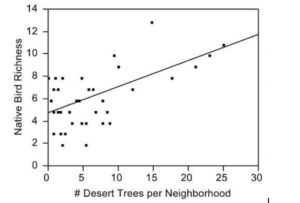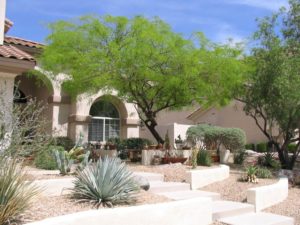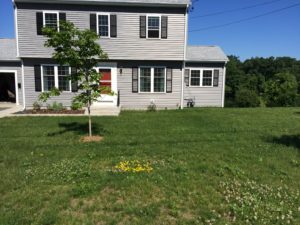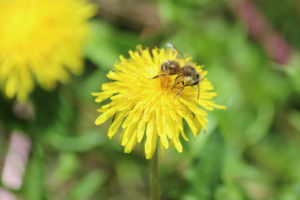Susannah B. Lerman, USDA Forest Service Northern Research Station, Amherst, MA
The birds and the bees represent some of our most familiar wildlife. Whether we witness an American robin hunting for earthworms in our lawns or marvel at an eastern bumblebee’s ability to hover while slurping nectar from dandelions, these and other species provide opportunities for urban and suburbanites to experience nature right on their doorstep. Unfortunately, with increased pressures from residential development, bird, bee and other wildlife habitat have disappeared, been fragmented and been altered, leading to severe population declines (Rosenberg et al. 2019, Vanbergen et al. 2014). Nonetheless, after the development phase, the novel habitat within the new landscape (both intentionally planted and remnant habitat) can support wildlife communities. However, habitat quality hinges on the management decisions made by individual householders. Although these green spaces result in small fragments of non-cohesive parcels, collectively, they have the greatest potential for increasing and enhancing habitat in urban and suburban areas.
From a landscape perspective, we might observe a homogenizing force with regards to the urban form of American cities and suburbs (Groffman et al., 2017). For example, from 30,000 feet above the ground, it is difficult to differentiate Boston from Phoenix. Birds inhabiting cities have also become homogenized, with most American cities supporting an abundance of European starlings, rock pigeons, and house sparrows. However, when we hone in on local scales, i.e., neighborhoods or even different land uses within a city, we find a tremendous amount of variation regarding habitat quality. Differences in tree and shrub composition, condition and density, and the specific management decisions and landscape can be drastic and subtle within and across neighborhoods. In addition to having implications for habitat quality, the heterogeneity can influence interactions with nearby nature.
Desert Plants for Desert Birds and People
Working within the Central Arizona Phoenix Long-Term Ecological Research (CAP LTER) project, we overlaid 40 bird monitoring locations with habitat surveys (e.g., quantifying desert plants and the absence of turf) in Phoenix, AZ, neighborhoods. This allowed us to test the efficacy of native landscaping in residential yards for attracting native bird communities. The research also highlighted the relative importance of socioeconomic data, features often ignored in urban bird ecology studies, and how these features relate to one another. Research further parsed out who might be observing what by exploring relationships between bird monitoring locations and US Census Block Groups. The novel, integrative, and interdisciplinary approach demonstrated that yards with desert landscaping supported higher abundances of desert birds, including birds unique to the Sonoran Desert, thus having conservation potential (Fig. 1). Yards landscaped with turf supported more generalist species, birds typically found in most cities in the US and beyond. Research also highlighted environmental inequities, namely that Latinx and lower-income neighborhoods had significantly lower native bird diversity, with more nuisance bird species and fewer native plants compared with their higher-income counterparts.

Figure 1. Phoenix, AZ neighborhoods with a high abundance of desert trees support more desert birds.
But do people notice these differences? The answer is yes. By partnering with social scientists and the Phoenix Area Social Survey (PASS; Larson et al. 2017), research assessed levels of satisfaction, a measurement of well-being, with the local bird community. Survey respondents had higher satisfaction in neighborhoods with higher levels of desert bird richness (Lerman and Warren 2011). In other words, discrepancies in access to biodiversity resulted in negative attitudes and interactions with the local fauna. What’s more, when repeating the study five years later, consistent patterns persisted though overall bird abundance declined in these 40 Phoenix neighborhoods (Warren et al. 2019). The 2011 research represented one of the first studies to provide a scientific basis for promoting native plants for attracting native wildlife in residential yards. The research also demonstrated some of the negative consequences of lawns for supporting biodiversity.

Figure 2. An example of a Phoenix yard landscaped with palo verdes (Parkinsonia florida), mesquites (Prosopis spp), and other desert vegetation.
Mow Less for More Buzz
Lawns cover more than 163,000 km2 across the US (Milesi et al. 2005), and Americans readily irrigate, fertilize and mow to adhere to social norms and create an aesthetically pleasing landscape. Because of the intensive management, many ecologists have criticized lawns as biological deserts and dismissed their habitat potential. However, given their ubiquitous presence in urban and suburban landscapes, it is practical and wise to consider alternative management practices that could enhance their habitat value. Can mowing less frequently result in more floral resources such as dandelions and clover, and hence more bees?

Figure 3a. Mowing lawns less frequently to allow dandelions and clover to flower (a) provides significant habitat for pollinators (b).

Figure 3b. Bee on a yard dandelion.
Research from 16 lawn-dominated yards in Springfield, MA, demonstrated that contrary to popular ecological belief, lawns, when chemical-free, support a surprising level of diversity. In fact, more than 64 flowering plants grow spontaneously amidst the turf. What’s more, 111 different species of bees buzz around these green spaces, the majority of these bees native to Massachusetts, and this number represent roughly a quarter of all bees documented in the state (Lerman and Milam 2016). As for relaxed management, yards mowed every three weeks had the highest floral abundance, yet yards mowed every two weeks supported the most bees (Lerman et al., 2018). Results highlight a ‘lazy lawnmower’ approach to providing bee habitat. In addition to planting pollinator gardens, householders and other lawn stewards can mow their lawns less frequently, saving time and money and not requiring new knowledge (Fig. 3a,b). Further, this research demonstrates how individual households can contribute to urban biodiversity conservation.
Thus far, research has demonstrated the value of native plants and less rigorous management. Can the patterns found in these studies apply to other cities?
Designing Yards for the Birds
Expanding single-city studies to include multiple management practices in multiple cities can further our understanding of whether and how urbanization has a homogenizing effect on biodiversity and the generalizability of these biodiversity patterns at a continental scale. Specifically, can yards managed for wildlife (e.g., wildlife-certified© yards as per the National Wildlife Federation) support similar levels of bird diversity compared with natural parks, or do they function like other more traditional yard designs, e.g., lawn-dominated? Recent research tested this question in a multi-city study that included Baltimore, MD, Boston, MA, Los Angeles, CA, Miami, FL, Minneapolis-St. Paul, MN, and Phoenix, AZ. These cities differ in climate and ecological biomes. They offer a great opportunity to test how birds respond to a variety of different yard management practices and whether similar patterns occurred across the US.
Overall, the bird communities in parks and yards primarily consisted of native species. Further, similar patterns persisted in all six cities; urban parks supported more species of conservation concern (an official designation of species whose long-term persistence is in question) compared with yards regardless of management. However, yards certified as wildlife habitats supported a wider variety of bird species compared with lawn-dominated yards (Fig.4; Lerman et al., 2021). This suggests that landscape management for wildlife can contribute to region-wide bird diversity. Yards, regardless of management, supported more popular species compared with parks (Fig. 4). By considering novel biodiversity metrics such as public interest levels (i.e., popularity) based on Google searches and bird sightings can highlight which species might resonate with decision-makers and stakeholders. This can allow research to better inform recommendations that enhance the conservation value of residential yards.

Figure 4. When comparing four different yard designs and two different types of parks, birds recorded in yards supported more ‘popular’ species regardless of design. However, yards certified as wildlife habitat (e.g., wildlife-friendly) had similar diversity (i.e., Turnover) as parks. Here, turnover indicates different species within the same type of yard design or park when comparing multiple sites.
In conclusion, research highlights how individual management practices at local, regional and national scales can improve the capacity of backyards for supporting wildlife and other ecosystem services.
—
Disclaimer: The findings and conclusions in this essay are those of the author and should not be construed to represent any official USDA or U.S. Government determination or policy.
About the Author
Dr. Susannah Lerman is a Research Ecologist with the USDA Forest Service Northern Research Station. With an expertise in wildlife ecology and urban social-ecological systems, Susannah translates the application of scientific information into management tools and shares her science with diverse audiences. Her research emphasis is on private lands, which provide opportunities for the public to participate in science, conservation, and shared stewardship. Her research program also aims to broaden participation in STEM, addresses environmental injustices, and proudly mentors a diverse and exceptional group of young and early career scholars.
Literature cited
Groffman, P. M., M. Avolio, J. Cavender-Bares, N. D. Bettez, J. M. Grove, S. J. Hall, S. E. Hobbie, K. L. Larson, S. B. Lerman, D. H. Locke, J. B. Heffernan, J. L. Morse, C. Neill, K. C. Nelson, J. O’Neil-Dunne, D. E. Pataki, C. Polsky, R. R. Chowdhury, and T. L. E. Trammell. 2017. Ecological homogenization of residential macrosystems. Nature Ecology & Evolution 1:s41559-017-0191–017.
Lerman, S. B., A. R. Contosta, J. Milam, and C. Bang. 2018. To mow or to mow less: Lawn mowing frequency affects bee abundance and diversity in suburban yards. Biological Conservation 221:160–174.
Lerman, S. B., D. L. Narango, M. L. Avolio, A. R. Bratt, J. M. Engebretson, P. M. Groffman, S. J. Hall, J. B. Heffernan, S. E. Hobbie, K. L. Larson, D. H. Locke, C. Neill, K. C. Nelson, J. Padullés Cubino, and T. L. E. Trammell. 2021. Residential yard management and landscape cover affect urban bird community diversity across the continental USA. Ecological Applications 31:e02455.
Lerman, S. B., and P. S. Warren. 2011. The conservation value of residential yards: linking birds and people. Ecological Applications 21:1327–1339.
Milesi, C., S. W. Running, C. D. Elvidge, J. B. Dietz, B. T. Tuttle, and R. R. Nemani. 2005. Mapping and modeling the biogeochemical cycling of turf grasses in the United States. Environmental Management 36:426–438.
Rosenberg, K. V., A. M. Dokter, P. J. Blancher, J. R. Sauer, A. C. Smith, P. A. Smith, J. C. Stanton, A. Panjabi, L. Helft, M. Parr, and P. P. Marra. 2019. Decline of the North American avifauna. Science 366:120–124.
Vanbergen, A. J., M. Baude, J. C. Biesmeijer, N. F. Britton, M. J. Brown, M. Brown, J. Bryden, G. E. Budge, J. C. Bull, C. Carvell, and others. 2013. Threats to an ecosystem service: pressures on pollinators. Frontiers in Ecology and the Environment 11:251–259.
Warren, P. S., S. B. Lerman, R. Andrade, K. L. Larson, and H. L. Bateman. 2019. The more things change: species losses detected in Phoenix despite stability in bird–socioeconomic relationships. Ecosphere 10:e02624.
***
Each author appearing herein retains original copyright. Right to reproduce or disseminate all material herein, including to Columbia University Library’s CAUSEWAY Project, is otherwise reserved by ELA. Please contact ELA for permission to reprint.
Mention of products is not intended to constitute endorsement. Opinions expressed in this newsletter article do not necessarily represent those of ELA’s directors, staff, or members.

